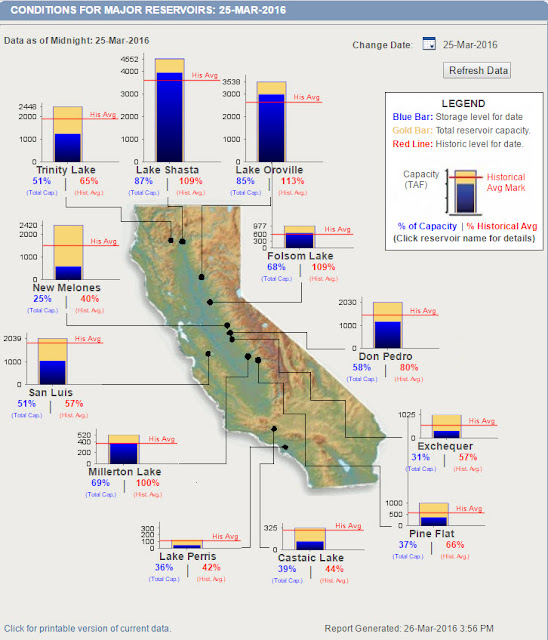Last week I was asked by my Rotary Club to give opening comments before a guest speaker from Lockheed Martin talked about new technology developments, so I decided to talk about water and technology.
To set the stage, we're having an unusually average water year in California. The story about Bill Gates walking into a bar and making the average patron a millionaire applies - California has lots of below-average years and a few really wet ones.
This year's precipitation is kind of average - most of the state had slightly above average rainfall, some slightly below. The
snowpack's water content is at or slightly below average. The reservoirs shown above are mostly below average due to the multi-year drought. Groundwater conditions are much harder to find, but we already know the answer - they range from not-good to extremely bad. What little more rain we'll get, however welcome, will not change any of this. We're still in a drought.
So in my comments I mentioned three technologies that could help water supply: low-tech, current tech, and future tech.
The low-tech model being tested now is
flooding farmland, even when plants don't need it, to maximize percolation for groundwater storage. This is different from flood irrigation, a common and wasteful way to water orchards and other crops that may have similar groundwater benefits but is taking water at the wrong time, when it's most needed in-stream. Flooding for percolation purposes is being tried in midwinter, and may replace an expensive large reservoir that we'd otherwise be pressured to build. It's an experiment to see how well it percolates and how well the orchards and other areas tolerate it, but seems like a good idea.
The current technological system to change water supply is
recycled water for potable use, something
I've talked about quite often. My former water district already purifies wastewater to this standard but only uses it for landscaping and industrial uses. In a few years we plan to start drinking it, which has been done for years in other places like Southern California and Singapore, and in space. The main technology involved is reverse osmosis - hardly new, but new techniques make it more efficient.
The same technology is used for ocean desalination, but it sucks up a lot more energy and has other environmental consequences. The biggest environmental difference between potable reuse and ocean desal - aside from energy - is that reuse works best at large wastewater plants in urban areas, limiting sprawl, but ocean desal can open up development in any location near the ocean.
Finally, the future technology I'd like to see applied is a
smart grid for underground, residential rainwater retention tanks with two-way pumps connected to storm sewers. When a storm approaches, the grid activates and pumps out the tanks in advance. When the storm hits, the tanks not only take in runoff from roofs but also pump water in from storm sewers, temporarily, shaving the critical peak off a flood. These tanks aren't just for rainwater, they're a form of flood protection, and their combined value makes them worth the price.
The
first smart cisterns are happening in Los Angeles, so making a grid use out of them is the next step.


















